The funds are of lower quality pavs. Powders with phosphates are harmful to health
Household chemicals, which includes various detergents and disinfectants tops the list of our daily essentials. But do not forget that everything has a downside: in the struggle for cleanliness, we can cause irreparable harm to both the environment and our health. An example of this is washing powder with phosphates.
The composition of modern washing powders includes more than 20 components, which are often dangerous chemical compounds: surface-active substances (surfactants), fat emulsifiers (phosphates), alkalis (alkali metal phosphates, soda) and other active ingredients (chemical and optical brighteners), substances for binding magnesium and calcium ions (sodium tripolyphosphate) and fragrances.
Hazardous Ingredients in Laundry Detergents with Phosphates and Others harmful substances can penetrate our body through the skin of the hands and body (when we wash with our hands without protective gloves), through water contaminated with sewage after washing (even cleaning with the most powerful filters does not desired results) and through the respiratory tract.
Why are these substances so harmful? About it Epoch Times said the environmental organization MAMA-86.
Surfactant:
- cause violations of the functions and integrity of cells, accumulate in the organs of the body;
- the action of surfactants is similar to the action of some poisons: they cause efinzema in the lungs, which in turn leads to an increase in cholesterol levels;
- change the physico-chemical parameters of the blood and harm the immune system;
- cause allergies
- increase the risk of infertility.
Phosphates, phosphonates:
- significantly enhance the toxic properties of a-surfactants and their penetration into the body;
- contribute to the degreasing of the skin, the active destruction of cell membranes, reduce the barrier function of the skin;
- can cause allergies and dermatosis;
- upon contact with the skin, they enter the bloodstream, changing the percentage of hemoglobin, protein, structure and density of blood serum, which leads to disruption of the internal organs, causes metabolic disorders, exacerbation chronic diseases and the emergence of new ones.
In synthetic detergents, phosphates are used to bind calcium and magnesium ions. Getting into environment, they cause the accelerated development of algae in water bodies. The toxins released by blue-green algae are dangerous to aquatic animals. In addition, blue-green algae worsen drinking qualities water, water acquires various smells and tastes.
Such polluted water, which contains cyanobacteria toxins, also causes the development of cancer cells, pregnancy problems, birth injuries, increased morbidity and a decrease in overall life expectancy.
For more than 20 years, the use of phosphates in laundry detergents has been banned in many countries.
Anionic surfactants (a-surfactants)
Cheap in production and highly soluble, but very dangerous for the body and nature.
Anionic surfactants can accumulate in organisms in significant concentrations, which reduces immunity, causes allergies, affects the brain, and causes diseases of the kidneys, liver, and lungs.
Cationic surfactants
They have bactericidal properties, but also affect the body and nature, although to a lesser extent than a-surfactants.
Nonionic surfactants
Like any "chemistry", they also affect the body and nature. But their advantage is 100% decomposition.
Other impurities
The mechanisms of the effects of impurities on the body are still being studied. There is already evidence that some of them adversely affect metabolic processes.
How to choose a safe washing powder?
1. If there is no data on the composition of the washing powder on the packaging, it is not safe to use it.2. When choosing a powder, carefully read the labels on the package, paying attention to the quantitative composition of the components, primarily surfactants and phosphates (phosphonates are just as harmful as phosphates; some powders say “without phosphates”, but there are phosphonates) .
3. Choose those powders that contain the least amount of surfactants and phosphates.
4. Choose products of everyday chemicals without a pronounced aroma, especially for washing baby clothes.
5. If possible, instead of washing powder, buy and use alternative detergents, such as laundry soap, soda.
Take care of your health and the environment!
According to the materials of VEOO "MAMA-86".
The most commonly used surfactants for skin cleansing are the main active ingredients in detergents, and they determine the strength of the agent (mild or irritating effect). Basically, when creating detergents, anionic (negatively charged) surfactants are used as surfactants, since they have the best ability to foam and lather. Since the detergents in the form of briquettes are solid due to the need to maintain their shape and structure, which must not change during the production process, it is possible to use only certain surfactants. In the manufacture of liquid detergents, on the contrary, there is a greater choice of active chemical components. In addition, the manufacturing process of liquid detergents is such that emollients can be included in them in greater volumes than in solid detergents. Structural formulas Surfactants most commonly used in the creation of solid and liquid detergents.
Surfactants in solid detergents
Soap (alkyl carboxylate) is the main surfactant in most solid detergents worldwide. Soaps, also called natural surfactants, are usually formed during the saponification of fats, during which a reaction occurs between a triglyceride and an alkaline compound. Commonly used in the manufacture of soap vegetable oils such as palm oil, palm oil derivatives (palm stearin, palm olein), rice, peanut or castor oil in combination with coconut or palm oil. The non-vegetable ingredients used to make soap are usually made from animal fats, such as low-grade lards. Although soaps are effective as cleansers, they have a negative effect on the condition of the skin. The use of soap, especially in countries with a cold climate, is associated with the appearance of erythema, xerosis and itching of the skin.

The ability of detergents to irritate the skin depends on several factors. The type of surfactant used is critical. Surfactants with a molecular chain length from C8 to C14 are the most active components in solution, so they have the most pronounced irritating effect. Soap-based detergents usually contain these surfactants. The irritating effect is also due to the fact that these detergents are poorly washed off the skin (surfactant radicals can remain on the surface) and increase its pH. If the pH of the skin remains elevated for more than 4 hours (for example, when using alkalinizing agents or washing the skin frequently), the alkalinity of the skin surface increases, which can lead to skin irritation. The pH for most soaps ranges from 9.5 to 11.0, which is typical for alkaline environment. As a result of attempts to reduce the irritating effect of soaps by adding additional components to their composition, new types of soaps have been developed, such as soaps with overfatting additives, transparent soaps and combined solid soaps.
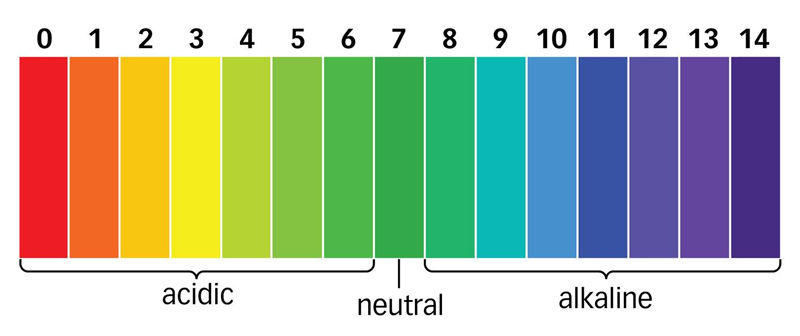
Soaps with regreasing additives.
These soaps are obtained by incomplete saponification (neutralization), during which fatty acids or oils do not react. They can also be synthesized by adding fatty alcohols, acids, or esters to soap during the manufacturing process. Usually, due to overfatting additives, the properties of soap products are improved, such as:
softness of action;
the ability to moisturize the skin;
foaming ability;
spending is reduced.
Transparent soaps.
These products contain high concentrations of moisturizers such as glycerin. Thanks to these humectants, which increase the solubility of the soap, it becomes transparent. However, these products are characterized by a high content of active detergents and an alkaline pH, which increases their irritant effect. Be that as it may, transparent soaps are classified as mild soaps, due to the presence of glycerin in their composition, which is a moisturizer, and a low content of fatty substances.
Combined solid soaps.
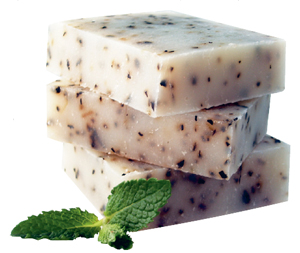
These products usually contain natural soaps and mild synthetic surfactants. Synthetic surfactants reduce the irritant effect of these agents, however, the pH remains high, approximately at the level of 9.0-9.5. Combination bar soaps are generally less likely to cause skin irritation than standard bar soaps.
Solid synthetic detergents.
Solid soaps containing surfactants are called solid synthetic detergents. Unlike soaps, solid synthetic detergents are obtained by esterification, ethoxylation and sulfonation of oils, fats or petroleum derivatives. Solid synthetic detergents typically contain the following synthetic surfactants:
sulfosuccinates;
sodium cocoyl sulfate monoglyceride;
sodium cocoyl isethionate.
sulfated esters of alkylglycerol;
a-olefin sulfonates;
Solid cleansing soaps (containing an alkyl carboxylate) have an alkaline pH value ranging from 10 to 10.5. In contrast, solid synthetic detergents (base substance alkyl isethionate) have a neutral pH. Additional components of solid synthetic detergents are refractory fatty acids, waxes and esters. It should be noted that sodium cocoyl isethionate, the most commonly used synthetic surfactant, has special molecular properties that were used in the development of a new direction in the production of detergents, namely, in the creation of mildly active substances.

Surfactants most commonly used in the manufacture of liquid detergents
Liquid detergents usually contain both anionic and amphoteric (containing a neutral charge) surfactants. Non-ionic surfactants and surfactants synthesized from amino acids are more and more often included in detergents, as they provide a gentle action of the agent. Anionic surfactants commonly found in liquid detergents include soaps (salts of fatty acids) and synthetic surfactants such as:
alkyl ether sulfate;
alkylaryl isethionates;
alkyl phosphates;
alkyl sulfosuccinates;
alkylsulfonates.
In the production of liquid detergents, anionic surfactants derived from amino acids (for example, acylglycinates) are most often used as the main surfactants. The most commonly used zwitterionic surfactants are cocamidopropyl betaine and cocoamphoacetate. One non-ionic surfactant found in some detergents is an alkyl polyglycoside. Surfactants derived from amino acids, such as alkylglutamates, sarcosinates and glycinates, are increasingly being used in the manufacture of detergents. Most liquid detergents have a neutral or acidic pH. An exception is products that are created using soaps (alkylcarboxylates) as the main active ingredient. The pH value of these detergents is alkaline.

Other Ingredients in Skin Washes
In addition to surfactants, detergents contain structurants, modifiers of organoleptic properties and fragrances. Fragrances are perhaps the most expensive ingredient in detergents, but their importance to consumers cannot be overestimated. In solid detergents, structurants are needed to maintain their "solid state" and to facilitate a rather complex production process. The most commonly used structurants are long chain fatty acids, waxes and alkyl esters. In the production of liquid detergents, structurants are used to provide the necessary rheological properties/density of the liquid, which affect the consumption and features of the use of the product. In addition, structurants provide the physical stability of dispersion-suspension systems and the presence of a moisturizing effect. Emollients are included in the composition of detergents in order to achieve a minimum drying effect on the part of surfactants. The most commonly used emollient/occlusive agents in moisturizing shower gels are triglyceride oils, fats, liquid paraffin, waxes and mineral oils. Water-soluble humectants such as glycerin can also be added to enhance the moisturizing effect.
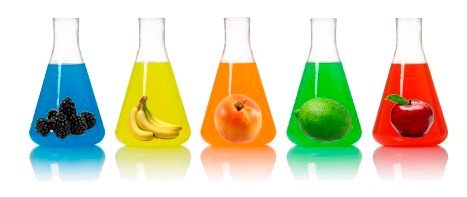
Detergents formulated for special effects may contain other additional active ingredients. For example, antimicrobial detergents often contain bactericides such as triclosan or triclocarban. A list of additional active ingredients used to achieve specific additional effects has been established by the FDA. The FDA oversees the safety of CMCs and detergents that have antibacterial or other drug-like effects. The safety of true soaps with no other effects is controlled by the Consumer Product Safety Commission. Detergents designed for frequent hand disinfection of healthcare workers or Food Industry, must meet more stringent requirements than the above products. These products usually contain strong cationic antimicrobials such as chlorhexidine or benzalkonium chloride. Additional ingredients such as salicylic acid or benzoyl peroxide are also found in facial cleansers designed to treat acne. Facial cleansers typically have a relatively low pH. With the development of detergent production technologies, thanks to which it was possible to achieve a positive effect of these products on the condition of the skin, they began to include additional components, such as nutrients and substances that reduce the manifestations of skin aging.
Hello connoisseurs of beauty and eco-friendliness! My name is Svetlana, and this is my first review of such a plan on this site. I've probably been interested in ecological products for beauty and home cleaning for a year now. And in general, for a year now, I began to pay more attention to myself and my health.
And of course, one day I had a question, or rather, I wanted to know more about how I clean the house, in particular, how I wash the dishes. When on the Internet I indicated the names of the components that make up "my product" with which I washed the dishes at that time, and read what kind of component it was and what it was made of, my hair slowly stood on end. Of the 10 ingredients on the product, as I remember now PRIL, one was of plant origin, everything else was synthetic. . And from that moment on, I began to pay more attention to how I wash the dishes and how I clean the house. From that moment on, I began to search the Internet more for information, how to figure out what was what, watch bloggers who realized what harm we do to our body with these means earlier than I did, and already have some experience in this matter. Thus, I stumbled upon the ecoville website. The first product that I ordered for washing dishes was Sodasan Pomegranate Concentrated Liquid Dishwashing Liquid. The composition can be read by clicking on the link. I used it until I found out that the anionic surfactants contained in this product are hazardous to health.
surfactant (superficial Active Substances) is usually chemical substances, which are contained in any cleaning agent, even ordinary soap. Just thanks to surfactants, the cleaning agent cleans. Why are surfactants needed?
The problem is that dirt, especially grease, is very difficult to wash off with water. Try washing greasy hands with water. The water will drain without washing off the grease. Water molecules do not stick to fat molecules and do not take them with them. Therefore, the task is to attach fat molecules to water molecules. This is exactly what surfactants do. A surfactant molecule is a sphere, one pole of which is lipophilic (combines with fats), and the other is hydrophilic (combines with water molecules). That is, one end of a surfactant particle is attached to a fat particle, and the other end to water particles.
Anionic surfactants- The main advantage is relatively low cost, efficiency and good solubility. But they are the most aggressive in relation to the human body. Cationic surfactants have bactericidal properties.
Nonionic surfactants- The main advantage is a favorable effect on the fabric and most importantly - 100% biodegradability.
Ampholytic surfactants- depending on the environment (acidity/alkalinity), they behave either as cationic or anionic surfactants.
Vegetable safe surfactants (sugar surfactants)
Of course, I didn’t order a product from Sodosan anymore, and began to look for something without the content of anionic surfactants, but on sugar surfactants. I met a girl at one meeting, she was a distributor of Siberian Health. And I took two products from her for testing. One of them is dishwashing liquid. Greenpin ECO Dishwashing liquid
Dishwashing liquid with an excellent composition, but for me it seemed not economical, very liquid, and there was still not a convenient pump that sprayed the product all over the kitchen. Although there were no complaints about the washing properties, I again found myself in search of my ideal remedy for washing dishes. And then I decided to look at the products on the ecoville website again
And I found there a remedy A remedy for hand wash tableware BIO Almawin
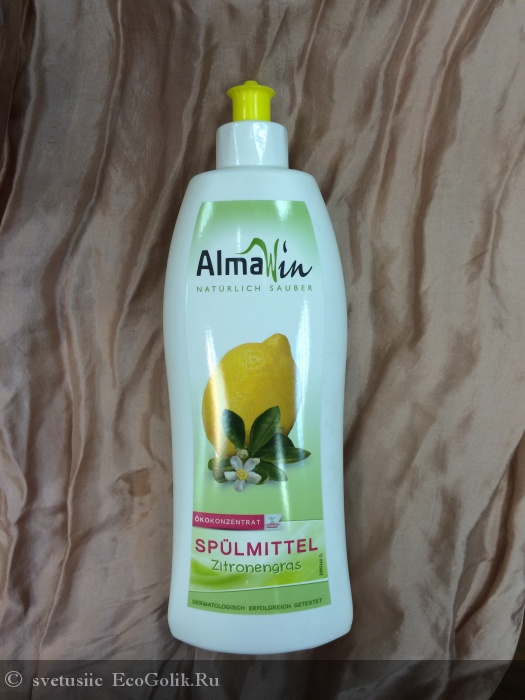

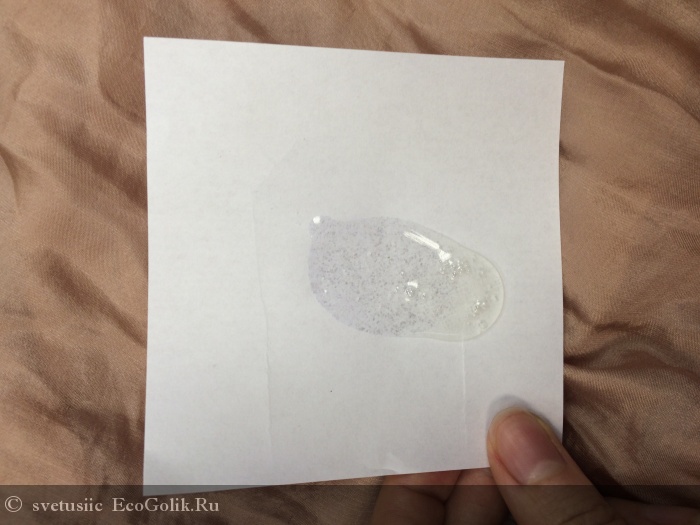
Economical ECO concentrate. Does not cause contact allergies and skin irritations. The dishes dry well, do not require wiping. Wheat proteins and glycerin protect the skin of the hands. The product is completely biodegradable.
Application: Pour water into the sink, add 1 drop (2 ml) of the product. Increase the concentration if heavily soiled.
Compound:
Sugar surfactant, organic sulfates from palm oil, ethanol, table salt, benzyl alcohol, wheat proteins, glycerin, lactic acid, essential oils lemongrass*, eucalyptus*, water (*certified organic). Moderate foaming.
Push I can say that I am satisfied with this tool so far, it does its job perfectly, it lasts for a month, it is not as liquid as the previous one. The smell is excellent, not intrusive, it smells like lemon, not chemical. I also like that it is colorless. Of course, ideally, I would like it without Ethanol and benzyl alcohol. I'll look, maybe I'll find something without these components. If someone is familiar with dishwashing detergents with a more beautiful composition, so that without alcohol and alcohols at all, then throw links, I will be grateful.
Thanks to those who read this article. Share your opinions. All happiness!
What actually washes?!
Surface Active Substances (Surfactants) are generally chemicals found in any cleaning product, even ordinary soap. Just thanks to the surfactant, the cleaning agent cleans. Why are surfactants needed?
Dirt, especially grease, is very difficult to wash off with water. The water will drain without washing off the grease. Water molecules do not stick to fat molecules and do not take them with them. Therefore, the task is to attach fat molecules to water molecules. This is exactly what SAWs do. A surfactant molecule is a sphere, one pole of which is lipophilic (combines with fats), and the other is hydrophilic (combines with water molecules). That is, one end of a surfactant particle is attached to a fat particle, and the other end to water particles.
How do surfactants affect our skin?
However, most of the moisture in the human body is also based on fat. Those. for example protective layer skin (lipids - fats that protect the skin from ingestion of various bacteria) is a fatty film and is naturally destroyed by surfactants. And the infection attacks the place that is least protected, which of course is harmful to human health. Surfactants also destroy body cells (destruction activity depends on the type of surfactant). Experts say that after applying the cleanser, the protective layer of the skin should have time to recover within 4 hours to at least 60%. These are the standards of hygiene established by GOST. However, not all detergents provide such restorability of the skin. Fat-free and dehydrated skin ages faster. In addition, surfactants can accumulate in the brain, liver, heart, body fat (especially a lot) and continue to destroy the body for a long time. And since almost no one can do without detergents, surfactants are constantly replenished in our body, providing continuous harm to the body. Surfactants also affect reproductive function in men, similar to radioactive radiation. The problem is exacerbated by the fact that our treatment facilities do not cope well with the removal of surfactants. Therefore, harmful surfactants return through the water supply to us in almost the same concentration in which we pour them into the drain. The only exceptions are products with biodegradable surfactants.
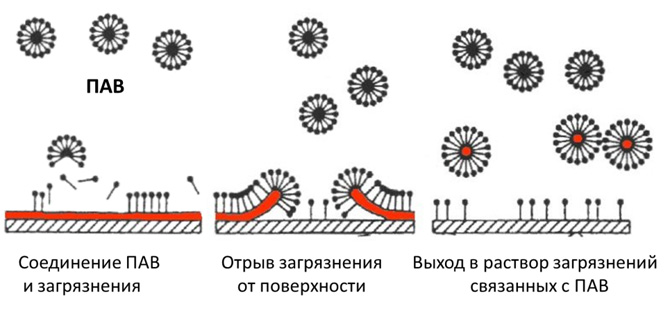
Types of surfactants, features and which ones are biodegradable
According to chemical nature hydrophilic group (soluble in water) surfactants are divided into four large classes: Anionic surfactants - in aqueous solution break down to form negatively charged ions. The main advantage is relatively low cost, efficiency and good solubility. But they are the most aggressive in relation to the human body. Cationic surfactants - in an aqueous solution decompose with the formation of positively charged ions, have a bactericidal property. Among cationic surfactants, quaternary ammonium compounds (QAC), imidazalines, fatty amines are of the greatest importance. Nonionic surfactants - do not form ions in an aqueous solution. The main advantage is a favorable effect on the fabric and, most importantly, 100% biodegradability. Amphoteric surfactants - in an aqueous solution, depending on the pH of the medium, they can exhibit cationic (in an acidic pH<7) или анионные (в щелочной среде рН>7) properties. Good biodegradability (by 80-98%) is possessed by some of the anionic (anionic) surfactants, for example, alkyl sulfonates. But nonionic surfactants have the most complete (100%) biodegradability. The inclusion of non-ionic surfactants in detergent formulations results in a lower content of anionic active substances on the skin. A similar effect, namely, a decrease in the accumulation of anionic surfactants on the skin and tissues, was established when enzymes of biological origin were introduced into detergent compositions. One of the main criteria environmental safety means of household and professional chemicals is the biodegradability of the surfactants that are part of them. Vijusa Bel uses exclusively anionic and nonionic surfactants. There are primary biodegradability, which implies structural changes (transformation) of surfactants by microorganisms, leading to the loss of surface-active properties. Complete biodegradability means the final biodegradation of surfactants to carbon dioxide and water.
The main use of surfactants is as an active component of detergents and cleaners (including those used for decontamination), soap, for the care of premises, equipment, tools, dishes, clothes, things, cars, etc. Currently, the most common surfactant in synthetic detergents is alkylbenzosulfonate. The group of anionic surfactants also includes alkane sulfonate (SAS), alkyl sulfate (FAS) and volatile alkyl sulfate (FAES). FAS can be obtained from vegetable raw materials, such as rapeseed oil, or coconut oil. In cationic surfactants, the hydrophilic group is represented by a positively charged, nitrogen-containing group. The chlorine ion, or methyl sulfate, acts as a negatively charged counterweight.
Why do you need Co-surfactant?
Since the actual washing action is formed mainly by anionic surfactants, they form the basis of any detergent. most common in production liquid soap is ethoxylated sodium laureth sulfate. A softer, but more expensive substance - ethoxylated magnesium laureth sulfate - is commonly used in children's cosmetics and products for sensitive skin. Ethoxylated ammonium laureth sulfate is often used in detergents made in the USA. In European products, it is less common, because in these countries its dermatological properties are considered insufficiently high. Unfortunately, products containing only sodium laureth sulfate as a washing substance are still widespread on the domestic market. These are very tough products, and no matter what useful additives (most often plant extracts) are included in their recipe, they do not correct the situation. For the best removal of dirt, dissolution of excess sebum, restoration of the protective lipid layer with dermatological softness and good foaming, it is necessary to use surfactant mixtures. Therefore, in addition to the main surfactant, Co-surfactant is always added to the detergent formulation. This is what helps to create an optimal balanced composition. Various amphoteric, nonionic, anionic and cryptoanionic surfactants are used as Co-surfactants. The ratio of surfactant and Co-surfactant is usually 1:3, 1:4. In practice, developers have to work out such ratios, taking into account the required cosmetic and specifications. Sometimes, when combined with absolutely safe surfactants, the mixture exhibits undesirable dermatological effects. High demands on the cleanliness of the environment encourage the creation of biodegradable surfactants (biosurfactants). The fact is that synthetic detergents are practically not subject to natural decomposition processes, therefore they can accumulate in the environment, causing considerable harm to nature. Biodegradable surfactants are metabolic products of bacteria or membrane components, that is, substances that, during external environment decompose into the original non-toxic components. An attempt to create biosurfactants was carried out abroad. They are obtained biotechnologically in the process of growing various microorganisms: bacilli, fungi, pseudomonads. By chemical structure they are very different, but overall advantage- safe from an environmental point of view.
On packages with detergents THERE ARE EXACTLY THESE THREE SAFETY SIGNS: "The sign of the cycle in nature." Used as packaging safe materials. The packaging can be recycled and reused. In addition, in nature it decomposes without forming hazardous chemical compounds such as dioxin. Thus, the purity of the soil and water is preserved. "Apple" - "Safety conscious formula". We use ingredients that are safe for our health and the environment. Such a mark is placed on the packaging of creams, personal care products, shampoos, etc. Hair sprays bearing this mark do not use gases such as propane and butane. Varnishes are sprayed due to mechanical action, and not due to the pressure that propane, butane or other gases create in a hermetically sealed canister. When spraying varnish, we do not inhale these gases and they do not enter the environment. "Bunny" - "No animal testing". Not tested on animals. This is not necessary, the manufacturer uses only safe components. And thus no harm is done to animals. Usually an animal test is needed in order to choose the concentration of chemical components that will not lead to dangerous consequences for animals and therefore for humans.
"The sign of the cycle in nature." Used as packaging safe materials. The packaging can be recycled and reused. In addition, in nature it decomposes without forming hazardous chemical compounds such as dioxin. Thus, the purity of the soil and water is preserved. "Apple" - "Safety conscious formula". We use ingredients that are safe for our health and the environment. Such a mark is placed on the packaging of creams, personal care products, shampoos, etc. Hair sprays bearing this mark do not use gases such as propane and butane. Varnishes are sprayed due to mechanical action, and not due to the pressure that propane, butane or other gases create in a hermetically sealed canister. When spraying varnish, we do not inhale these gases and they do not enter the environment. "Bunny" - "No animal testing". Not tested on animals. This is not necessary, the manufacturer uses only safe components. And thus no harm is done to animals. Usually an animal test is needed in order to choose the concentration of chemical components that will not lead to dangerous consequences for animals and therefore for humans.


